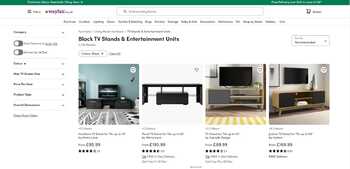The power of long-tail search categories
The future of e-commerce SEO strategy is here...and it’s long-tail search categories.
TL;DR Watch a 3 minute overview that takes you through real life examples of what a long tail category is and why it's so useful.

What exactly are long-tail categories?
Long-tail categories are longer, more specific keywords that potential customers are more likely to use when searching for a product or service. Because their aim is to help already-engaged users find the exact item they’re looking for, they can be hugely beneficial for your online business or e-commerce platform.
Here’s an example of how long-tail categories work. If your company sells garden furniture, there’s a good chance that your site isn’t going to be listed at the very top of a results page when the user searches: garden furniture—it’s too general and there’s far too much competition.
But, if you specialize in handmade oak swing seats with bespoke engravings, for instance, those specific search terms are going to reliably target those customers looking for that particular product. With long-tail categories, your aim is to capture users looking to buy—and not just browse—by delivering relevant pages for high-intent search traffic.

By why not just create a new category page for that product?
We’re glad you asked...
Now let’s apply that logic to a company that sells 12 different styles of sweatshirts, in 10 different colours—that's already potentially 120 categories to wrestle with if you wanted to target each of those long-tail categories!
It’s simply not feasible to manually create individual categories for each search term. With this state-of-the-art SEO tool, you have the ability to work with e-commerce filters that automatically create these categories.
Long-tail keywords use your existing product attributes—the ones currently powering your product listing page (PLP) filters—and create new dynamic pages that are invisible to search engines.
Real World Examples: Gymshark vs Wayfair

Above is the Gymshark website. The user has filtered the types of t-shirts by 'red', but the main page itself is still within 'T Shirts and Tops'. It's useful when you're on the page, but you wouldn't be able to search 'red t shirts gym shark' and land on this filtered view.
It's fine once the user is on the website - but they're missing out on potential traffic.

Here's the Wayfair website showing how long-tail categories can be used. The user has filtered TV stands to show 'black', just the same as the Gymshark example. But here, that reloads the page as a specific 'black TV stands' category that's indexable and searchable with Google.
Wayfair are hoovering up these long-tail keywords and getting even more targeted traffic.
Better communication with your customers
At its core, long-tail keywords are a means of establishing a clean line of communication between your business, and the consumer who is already actively looking for a certain product. While you might generate less traffic—those who are visiting these clearly-defined pages are much more likely to make a purchase.
Standard e-commerce platforms are built to focus on head terms, which make up just 30% of search engine traffic. With long-tail categories, you’re zeroing in on the remaining untouched 70%.

How it can help your business
By adding long-tail categories to your existing products, not only are you immediately boosting your chances of capturing organic traffic, you will inevitably achieve a better search engine ranking, and, importantly, transform your conversion rates.
Meanwhile, there’s also a huge potential for advertisers running costly search marketing campaigns.
Put simply, when you bid on long-tailed keywords, the cost per click is lower, since there’s less competition. Indeed, by focusing on longer, more specialised long-tail keywords in your AdWords campaigns, you can achieve higher ad rankings on specific searches without having to pay exorbitant costs for every click!
How can Sonder help?
The uber-talented Sonder development team is hard at work bringing long-tail categories to their SEO packages. This cutting-edge technology is only being used by a very select group of big ticket online retail companies, so we’re thrilled to soon be able to offer this service to our clients. If you’d like to know more, or would like to discuss how long-tail categories might benefit your business, please don’t hesitate to get in touch.
Other Relevant Resources
There's always more to learn, we recommend these blogs:
Posted by Steve Towells on November 5th 2021




